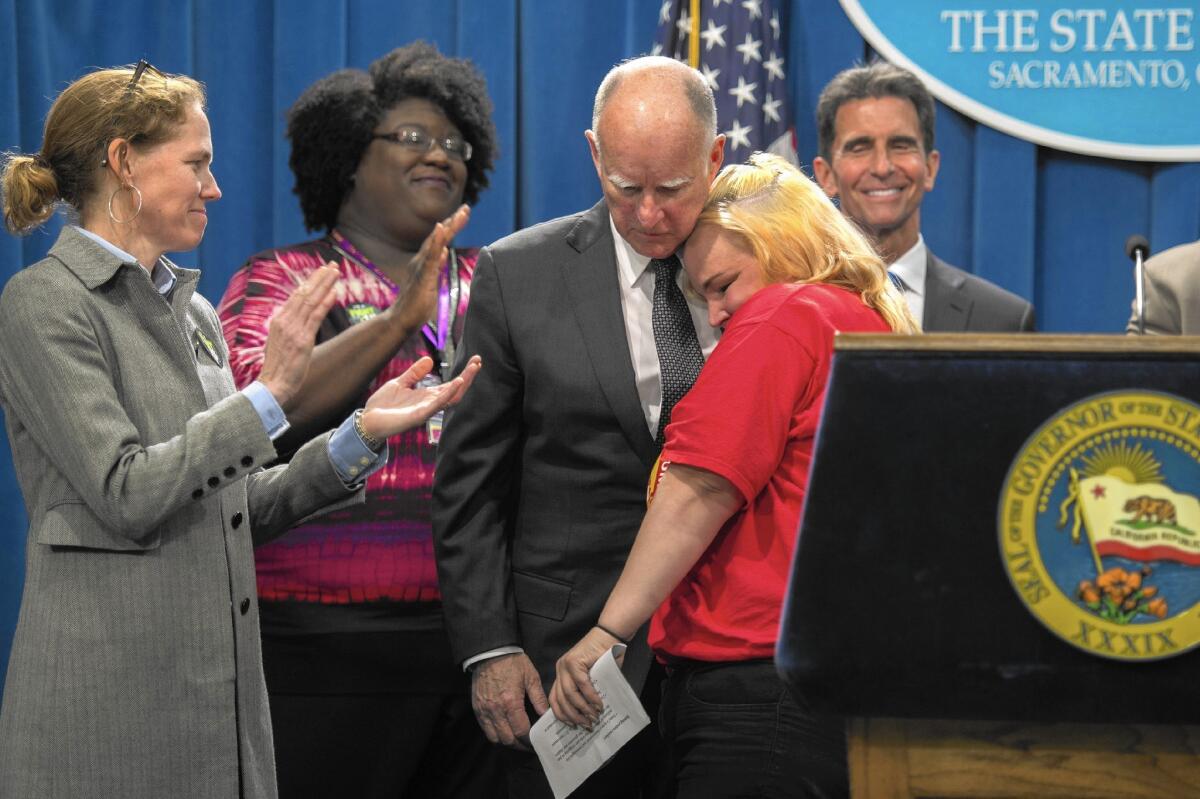Who wins with a $15 minimum wage?

Gov. Jerry Brown hugs Burger King worker Holly Diaz, 38, of Sacramento. She’s worked for the minimum wage for nine years.
The people who stand to benefit most from minimum wage hikes across California are low-income adults, most of them household breadwinners, according to an analysis by UC Berkeley’s Center for Labor Research and Education.
A law proposed by Gov. Jerry Brown would gradually lift the statewide minimum wage from its current $10 to $15 an hour by 2023. About 800,000 workers were already promised raises to $15 in several cities that passed their own minimum wage hikes, including Los Angeles, San Francisco and Santa Monica.
More than a third of the state’s workers would benefit from those moves, UC Berkeley estimates.
“California’s proposal would be the highest minimum wage we have seen in the United States, and because of California’s sheer size, it would cover the largest number of workers,” said Ken Jacobs, chairman of the UC Berkeley center. “This is a very big deal for low-wage workers in California, for their families and for their children.”
Nearly half, or 48%, of workers who stand to get a raise have a household income that is twice the federal poverty threshold or below, UC Berkeley estimates.
An individual at that level takes home $24,662 a year or less, while a family of four makes $48,894 or less. The median household in California earns $61,489.
Ninety-six percent of employees who would be affected are at least 20 years old, and more than a third have children. Seventy-two percent are Latino, black or Asian.
The average worker who would get a pay bump under Brown’s proposal provides slightly more than half of his or her family’s income.
The UC Berkeley estimate also includes some who earn slightly more than the lowest wage and stand to benefit from a ripple effect as businesses dole out raises to try to maintain a pay scale based on experience, Jacobs said.
If Brown’s plan passes, 5.6 million low-wage workers would earn $20 billion more in wages by 2023, according to the UC Berkeley analysis. It assumed no net jobs would be lost as businesses look to trim costs.
For Roberto Aparicio, 25, the raise would come at an opportune moment. Aparicio, a forklift worker who lives in Highland Park, already has one child and is expecting another baby. He makes $10 an hour, and said he’d invest the extra income in his family.
“I’ll be able to pay my bills on time, maybe look for a better house that I could live in,” Aparicio said. “If they bring it up a little bit, you give people more opportunities to rise up, invest. We have more opportunity.”
Times staff writer Sam Masunaga contributed to this report.
See more of our top stories on Facebook >>
MORE ON MINIMUM WAGE
Gov. Brown hails deal to raise minimum wage to $15 as ‘matter of economic justice’
Timeline of minimum wage increases in California
Your voices: What do you think about the minimum wage proposal?
More to Read
Inside the business of entertainment
The Wide Shot brings you news, analysis and insights on everything from streaming wars to production — and what it all means for the future.
You may occasionally receive promotional content from the Los Angeles Times.











